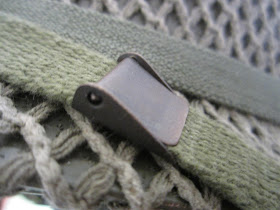As Dara of the Vikings reminds us...
helmets are nothing new to the Danes.
The m.48 is another clone of the American M1 helmet; and, as with all European
copies it is of very high quality.
The m.48 was introduced in 1951 and used by Danish troops through the mid-1990s,
eventually to be replaced by the Spectra m.96.
The liner, again nearly identical to the US M1 was manufactured in Denmark by
Dansk Industri Kunststof. Today DKI makes a broad variety of injection-molded and extruded products (check the maker of that plastic office chair you're sitting in).
Where the liner chinstrap on the American liner was leather,
the Danish version is fabric webbing.
Even the almost-never used insignia grommet mirrors the early M1 liner.
Initially the Danes used large stocks of American M1s
that were in such abundance following the Second World War.
Later the shell, still an import, was produced by one Austrian and two German firms.
The helmet, with liner, weighs in at 3.21 lbs.
The non-reflective surface is robustly rough and anti-reflective.
The stud and garter fastener is identical to the
US M1 liners made prior to 1964...
as are the arrowhead-shaped "A" washers that secure the suspension and nape strap.
The familiar American-style headband clips appear in nearly all M1 clones. The spring steel clips with gripping teeth are an elegantly simple fastening solution.
The Riddell suspension is gathered with stout cord, making the depth of wear adjustable.
The cam adjuster is typical of the M1 and its clones.
The Danes utilized the US m.1944 camouflage net as a standard issue
accessory for the m.48.
The reliable Riddell suspension is identical to the US M1. If it ain't broke, don't fix it.
The chinstrap is affixed to the swivel bail with T1 style clips
making the chinstraps easy to replace.
The chinstrap is fastened with the familiar ball-and-clevis buckle system.
Length of the chinstrap is adjusted by sliding the webbing through a simple steel keeper.
A classic design that soldiered on with the Danish army for over 40 years,
and a delightful addition to the collection.





























